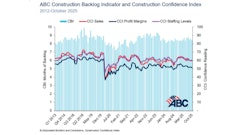
Construction professionals carry the critical responsibility of delivering structures that are safe, habitable, accessible and energy efficient. A key component of that responsibility is adherence to current building codes and compliance best practices — both of which are essential for ensuring successful outcomes across every phase of a project.
A foundational best practice is maintaining up-to-date knowledge of the California Building Standards Code (Title 24), a comprehensive set of regulations. California has some of the most complex and stringent building codes in the United States, primarily within Title 24 of the California Code of Regulations. These codes are designed to ensure public health, safety, and welfare, and they cover a wide range of building-related issues, including structural, electrical, mechanical, plumbing, energy efficiency and accessibility. For construction professionals, navigating and maintaining compliance with the latest adopted building codes is crucial. It's essential for construction professionals to have a solid understanding of its structure and the specific parts that apply to their facilities. Title 24 incorporates and amends national model codes, so familiarity with both is important. Key parts include the California Building Code (CBC), California Electrical Code (CEC), California Mechanical Code (CMC), California Plumbing Code (CPC), California Energy Code (CEC), the California Green Building Standards Code (CALGreen), and the California Existing Buildings Code (CEBC).
Stay Updated
California building codes are updated every three years, with an intervene update at the halfway mark, with supplements and errata changes. Construction professionals must have a system in place to track these changes and ensure that their facilities remain compliant. A best practice is to ensure that permit application forms are completed and turned in prior to the end of a triennial code cycle. This will ensure that the project’s design documents will be approved within a familiar building code cycle. Subscriptions to code updates, membership to relevant professional organizations such as the International Code Council (ICC) or California Building Officials (CALBO) and regular communication with local building departments are essential. It’s not enough to rely on base model codes — professionals must also monitor local amendments, supplements, and errata specific to their jurisdiction, such as those issued by the City or County of San Diego. Ongoing education through workshops, seminars, research and industry resources is vital to staying compliant.
Procedural compliance is equally non-negotiable. All necessary permits must be obtained from the local jurisdiction before any construction begins. All required permit application forms must be completed accurately. The scope of work on the plans must align with the approved application forms — as any deviation can delay schedules and increase costs. Effective compliance begins well before construction starts. Preparing accurate, code-compliant construction plans and documents is critical. These documents — often developed by licensed architects or engineers — must clearly demonstrate how the design meets, for example, structural safety, fire protection, energy efficiency and accessibility requirements.
Early engagement with local building department staff during the design phase helps clarify expectations and avoid costly revisions down the line. Some jurisdictions provide a discretionary or preliminary plan review service prior to submitting documents for a permit. Construction professionals should research the jurisdiction of a potential project and learn whether this service is available early in the process. Take advantage of every opportunity to discuss local compliance concerns early on to avoid costly delays. Another best practice is to add sufficient time for the review process. Depending on the size of the project and the quality of the documents and plans submitted, the permit approval process could take six months or longer. However, most jurisdictions do offer an expedited review service for a fee.
During scheduled inspections — including foundation, framing, MEP and final — any issues must be addressed quickly and documented thoroughly to maintain a clean compliance record. It is best practice to schedule a pre-construction (precon) meeting on-site with the assigned inspector or senior inspector before construction begins. This provides all parties a chance to ask questions, discuss concerns, learn about a jurisdiction’s processes for calling inspections in and define expectations for both parties. It’s also helpful to prepare a checklist of major concerns or milestones.
Some other things to learn early include:
- Specific requirements for elevation and/or property line surveys
- Soils investigation reports
- Special inspection reports
- What is required at a frame inspection — for example, some jurisdictions want the roof loaded and exterior weatherproofing in place
- Can any portion of the project be self-certified
- Are virtual inspections allowed
- Whether a temporary certificate of occupancy is allowed
Another critical best practice is to gain an understanding of the requirements to obtain the final occupancy certificate. Many projects get hung up here unnecessarily due to a lack of understanding. Many jurisdictions require landscaping to be in place, for example. Lastly, make sure that the approved plans and permit record cards are always on-site.
Successful projects depend on strong collaboration. Working with licensed, reputable contractors, architects and engineers who are well-versed in local codes helps prevent missteps. Open communication between project teams, code consultants and building officials promotes alignment and reduces miscommunication — ultimately leading to smoother approvals and timely occupancy. Construction professionals who adhere to these best practices will be well on their way to achieving the successful completion of their project. Maintain up-to-date knowledge of the California Building Standards Code. Procedural compliance will help ensure that the correct permit applications are submitted along with plans that are designed to meet local standards.
Ultimately, following building inspection best practices will help ensure that inspections pass the first round as much as possible and will help ensure that a client’s move-in date does not get extended. Most importantly, you will be delivering a safe, energy efficient, accessible and code-complaint structure that keeps people comfortable and safe.



















